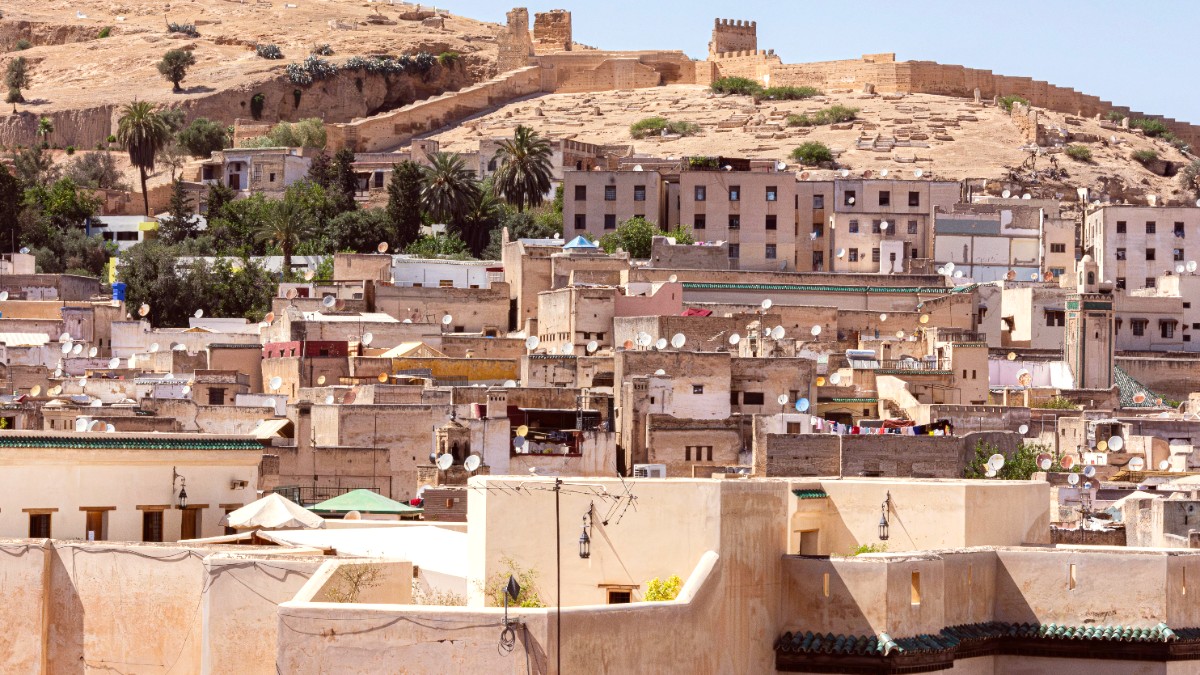
The Mediterranean Coast And The Rif, Morocco
Moroccan cuisine reflects centuries of cultural exchange, blending Berber, Arab, Moorish, Jewish, and Andalusian influences. Fes, with its deep history, has a special place in this culinary tradition, known for its refined and elaborate dishes. Food is central to Moroccan hospitality and social life, a way to connect and share.
Fassi cuisine often balances sweet and savory elements, using dried fruits (prunes, apricots) and honey alongside meats and spices. Dishes are aromatic, subtly spiced, and deeply flavorful.
Fassi cuisine is renowned for its sophistication and complex dishes. It frequently features slow-cooked stews, intricate pastries, and unique spice blends that distinguish it from simpler, more rustic cooking in other Moroccan regions.
Handwashing, eating with the right hand from communal dishes, and sharing mint tea are common dining customs. Take food from the section directly in front of you.
Breakfast is typically light. Lunch is often the main meal of the day (1 PM - 3 PM). Dinner is generally lighter and later (after 8 PM).
A slow-cooked stew named after the conical clay pot it is cooked in. Popular varieties include chicken with preserved lemon and olives, beef with prunes and almonds, and hearty vegetable tagines. Widely available at most restaurants and local eateries.
Essential to Moroccan dining.
Steamed semolina served with a stew of meat (often chicken or lamb) and a variety of vegetables. Traditionally served on Fridays for lunch, but many restaurants offer it on other days.
A staple, especially on Fridays.
A hearty, traditional Moroccan soup. It usually contains tomatoes, lentils, chickpeas, and sometimes lamb or beef. Often served to break the fast during Ramadan, but available year-round.
A comforting and popular soup.
The national drink. Sweet green tea brewed with fresh mint leaves. Served with ceremony and hospitality.
Fresh Orange Juice: Abundant and inexpensive. Coffee: Traditional Moroccan coffee, espresso, and café au lait are common.
Many upscale riads host excellent in-house restaurants serving refined Fassi cuisine. These often offer set menus and require advance reservations. Restaurant Dar Hatim and Nur Restaurant at Palais Faraj. They provide an elegant atmosphere and a curated culinary experience.
Mid-range options exist within both the medina and the Ville Nouvelle, granting a good balance of quality, ambiance, and price. Look for restaurants associated with mid-range riads or stand-alone establishments. Budget eateries and street food are plentiful, notably in bustling areas.
Brochettes (kebabs), Msemen (flaky fried bread), Bocadillos (sandwiches), Loubia (stewed white beans), Maakouda (potato fritters), and Snail soup (Babbouche) are popular street food specialties. Snail soup is an unique, savory-spicy broth.
Central Market (Marché Central) in Ville Nouvelle for fresh produce, spices, and some prepared foods. Souks in the Medina specialize in spices, olives, or dried fruits, great for exploring ingredients.
Various sections specialize in specific food items.
International cuisine predominantly found in the Ville Nouvelle (French, Italian, fast-food). Within the medina, international food choices are very limited; the focus is on traditional Moroccan fare.
Larger hotels often have diverse dining menus.
Vegetarian tagines & couscous are common. Specify "bila lahm" (without meat).
All meat served is Halal. Kosher food is rare.
Can be challenging. Carry translated allergy card.
Inform accommodation in advance. Use translated phrases.
Don't hesitate to inquire about ingredients or preparation methods. Local chefs are often helpful.
Clearly state your dietary needs.
A translated allergy card or common phrases can greatly with communicating needs.
Consider using a translation app for complex queries.
While delicious, ensure street food is cooked fresh and hot. Opt for popular stalls with high turnover.
In traditional eateries, communal dining is common. Use your right hand and take food from your section.
Hands-on classes learn Moroccan cuisine. Many riads and schools them.
Often start with a market visit for ingredients.
Prepare tagines, couscous, and traditional dishes. Classes at Cafe Clock or The Ruined Garden.
A spiritual and rhythmic style of music with West African roots, often at cultural centers like Café Clock.
Live performances available.
An internationally renowned annual festival (May/June), featuring spiritual music and arts from around the world.
Check dates in advance.
Learn basic Moroccan Arabic (Darija) phrases through casual interactions at your riad or with guides.
Some tour operators or riads arrange this for an authentic cultural experience, a look into Moroccan home life.
Fes has a deep and refined culinary tradition influenced by centuries of cultural exchange, with diverse dining options.
Always drink sealed bottled water to prevent stomach upset.